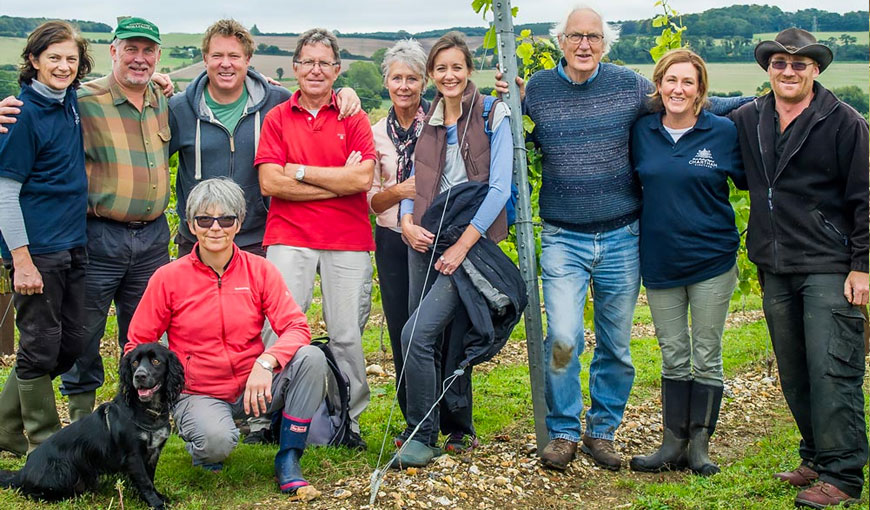Our vineyard sits above the River Stour, just below the North Downs Way (an ancient footpath used by Pilgrims on their inspirational journeys to the City of Canterbury, located three miles to the North East).
To join our small team of volunteer harvest pickers, please contact us.

The vineyard faces south across the valley of the River Stour which drains the Weald of Kent. This aspect makes the most of all available sunshine providing a relatively warm and dry microclimate, whilst allowing frost drainage into the valley below.
The vines are rooted in a dark-brown flinty loam on a massive chalk bedrock, formed over 100 million years ago from shells of sea creatures in a tropical sea. The chalk provides free drainage and the flints have an additional benefit of retaining daytime heat and maintaining the warmth of the soil.
A chalk pit on the farm nearby is designated as an important geological site, because the flint and marl bands can be correlated with the same Upper Cretaceous sequences across the Anglo-Parisian Basin, which includes the Champagne region.
In 2012 we underwent an intense period of planning and preparation involving site selection and soil preparation. Key decisions were made about the choice of grapes, rootstock and vineyard design. We chose the same variety of vines as those approved for Champagne; and clones and rootstock combinations to suit the prevailing soil and climate conditions.
After sub-soiling and harrowing, 1.6 hectares of vines were planted by machine in May 2013 with rows orientated up and down the slope to achieve maximum sunlight exposure.

In May 2014, we planted an additional 0.5 hectares of a Burgundy clone of Pinot Noir to produce colour for rosé or a still red in exceptionally good years.
All vines are grown on a standard vertical shoot positioned trellis with the fruiting wire 60cm. The overall trellis height is 2 metres, and the vines are trained on a traditional single-guyot system that is ideally suited to English conditions, giving a good balance of leaf and fruit to achieve maximum ripeness in our English climate.
At a time when environmental and sustainability issues are at the forefront, we are busy working towards being accredited under the Sustainable Wines of Great Britain scheme.
This is a rigorous, audited process which requires us to manage the business in a sustainable way - including maintaining and improving soil health, reducing pesticide use, promoting biodiversity in and around the vineyard and reducing our carbon footprint.
We are already doing some of these things and aim to demonstrate through documentation, record keeping and future planning just how effective we are.

Our grape harvest usually takes place from mid-September through to October. We set the actual dates after regular sampling and testing grapes in the field from mid-September, using a hand-held refractometer.
If these initial tests are promising we then begin to take more accurate measurements (acid titration and hygrometer tests for specific gravity) at regular intervals, to build up a picture of the changing sugar and acid levels for each grape variety.
Our winemakers John Worontschak and Matthieu Elzinga at Litmus Wines review these figures, then confirm the picking dates for each variety.
Our harvest team of family and friends are briefed in the vineyard before picking grapes into crates. These are loaded into a tractor bin and taken to the farmyard for delivery by truck to Dorking where they are weighed and made into our wine:
Towards the end of October we lay on a post-harvest supper in our old Kent Barn at Burnt House Farm, to thank volunteers for their support.
To join our small team of volunteer harvest pickers, please contact us.
Long history of viticulture in Chartham, Kent.
There is a long recorded history of viticulture in the area. The Domesday Book mentions several vineyards in East Kent, including Chartham, and there is evidence of wine trading between the manors. The wine produced in these Kentish vineyards was probably a sour variety and needed to be sweetened with blackberry wine. In spite of its sourness and the uncertain yield in this northern climate, the number of vineyards increased through to the 13th century. In 1303 Prior Henry of Eastry built a manor at Deanery Farm and established vineyards. Records show that Prior Henry’s vineyard at Chartham incurred considerable costs of maintenance;
1286 Repairing the winery, 66 shillings and 7 1/2 pence
1292 New gate for vineyard with palings, 67 shillings and 3 pence
1297 Repairing the winery with appurtenances plus new stables, £30, 19 shillings and 6 pence
1310 New press house and cart house, £6, 3 shillings and 2 pence.At this time the renowned Sir Robert de Septvans was active in the area as Constable of Rochester Castle, with the responsibility for controlling flooding and drainage in Kent and Sussex. He died in 1304 and his burial in Chartham church is marked by one of the greatest monumental brasses in the country. He stands in chain mail, richly ornamented, with seven winnowing fans (Septvans) and a lion at his feet.
The marriage of Henry II to Eleanor of Aquitaine in 1152 created a vast kingdom which included the best vineyards of France, resulting in the gradual reduction of English wine production due to easy access to French wines. The onset of the Little Ice Age in the mid-13th century led to cooler summers, and the Black Death which followed in the mid-14th century led to a huge reduction in agricultural labour, yet another setback to viticulture in this country.
LOCAL MAP 1729


